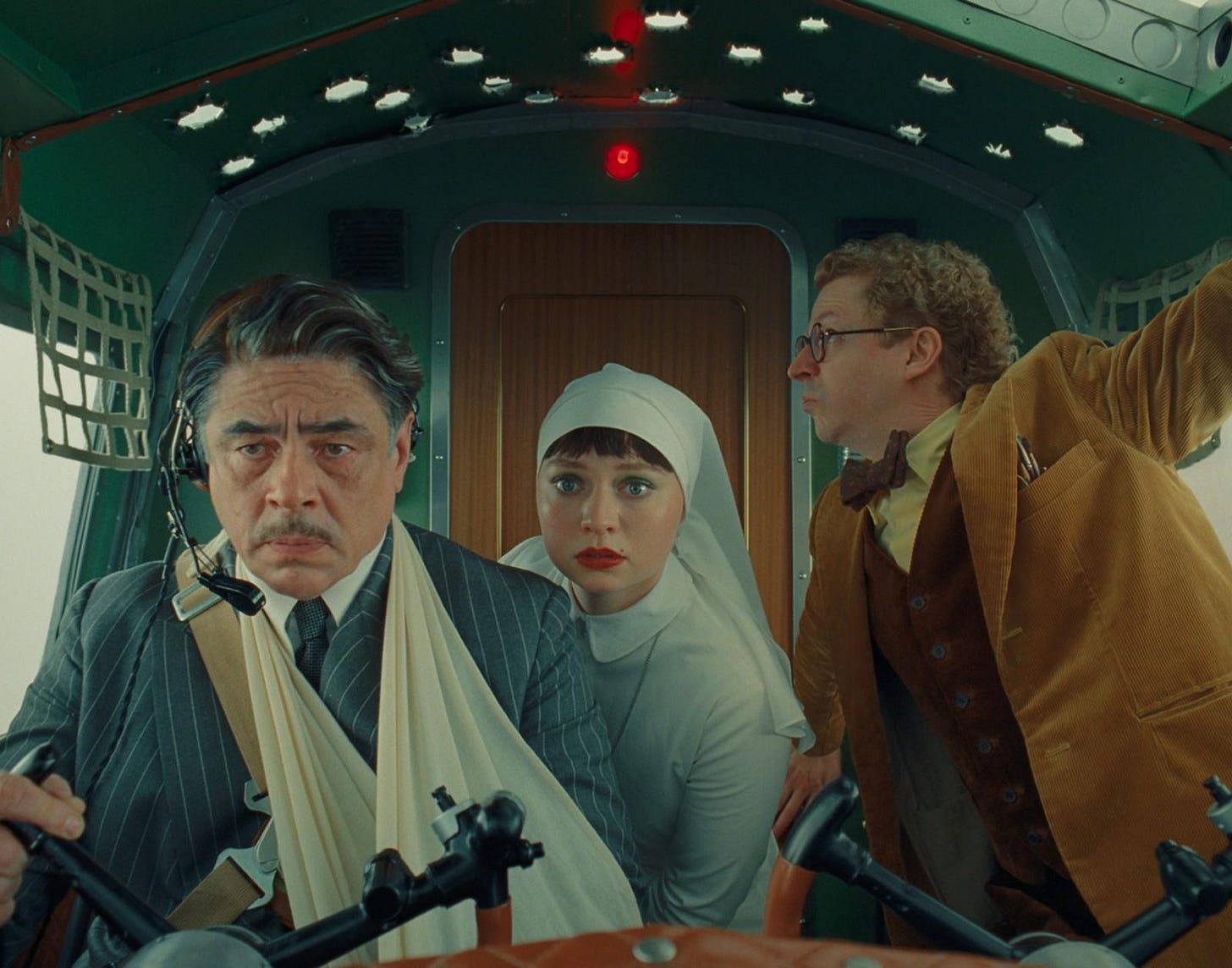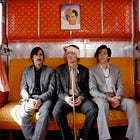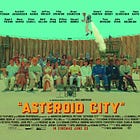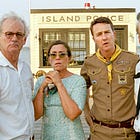The Phoenician Scheme (2025) Magnificent Mayhem from Wes Anderson
“Help yourself to a hand grenade!”

1950 — Above the High Balkan Flatlands
Altitude 5,000 feet
Dissolving into a garishly bright cabin of an aeroplane we immediately find “Zsa-Zsa Korda” (Benicio del Toro) smoking a cigar, well dressed and reading a book entitled “Great Botanical Collections” in the foreground whilst a much younger man sits in the rear of the cabin, staring at the ceiling. Whilst Zsa-Zsa is perfectly calm and at ease during the flight his presumed assistant in the background is anything but as the first rumblings of Alexandre Desplat’s musical soundtrack reverberate like distant gunfire around the cabin. A disconcerting sound at the front of the aeroplane draws the attention of both men as director Wes Anderson moves his camera to focus solely on Zsa-Zsa, cigar firmly wedged in his mouth, as he looks behind him at the frightened young man at the rear of the cabin. Barely a second passes before the top half of the young man is ripped violently from his body and sucked out of a now huge gaping hole in the side of the aeroplane.
Calmly placing his book in the seat holder, Zsa-Zsa inches his way forward toward the cockpit and the back of a panicking pilot skimming quickly through a book entitled “Emergency — Forced Landing”. As the windscreen wipers flap furiously, Zsa-Zsa settles himself into the co-pilot’s seat and after strapping himself in, instructs the pilot to maintain their current altitude and to seek a “more survivable crash site”. As the pilot repeats the command of the businessman now sat calmly beside him, director Anderson moves his camera to the exterior of the doomed aeroplane and as one of the two engines catches fire, he zooms quickly through the window on Zsa-Zsa’s reaction as the pilot, now turning from mild terror to outright panic, releases a verbal tirade at Zsa-Zsa and “If we survive this, I’m reporting you to the transnational aviation authority”. Nonplussed and calm in spite of yet another assassination attempt on his life, Zsa-Zsa replies “You’re Fired” as he hits the ejector seat button, sending the pilot skyward and out of the aircraft. Now in full control of the aeroplane, Zsa-Zsa calls in a mayday and his only viable crash sites immediately open to him, namely a cornfield straight ahead.
We cut to a wide shot of a cornfield before a close-up of the field lightly blanketed in drifting smoke and with a camera move slowly to the right, the film’s opening narration begins:
“At this moment, rescue workers are labouring to extinguish the fiery wreckage of an ill fated, dual engine aircraft in a perhaps futile attempt to recover and identify the remains of Zsa-Zsa Korda”
Director Anderson settles his camera on the smoking wreckage of the aircraft seen so far as well as a large chest or trunk embossed with “AZK — Land and Sea Ltd” and some smaller chests scattered around the crash site together with several books on topics such as beetles, flying insects and “Poisonous Stinging Spiders”. The narration continues:
“International businessman, maverick in the fields of armaments and aviation and among the richest men in Europe, this was Korda’s sixth recorded aeroplane crash”
More smoldering wreckage now and yet more books are scattered throughout the crash site and as Anderson moves his camera to the right we first see an untouched and perfectly in order crate of hand grenades, the rear tail section of the crashed aeroplane in the background, a large “Diplomatic Pouch” and as a black raven caws midway through, the narration continues:
“Dogged for years by accusations of profiteering, tax evasion, price fixing and bribery, Korda specialised in the mediation of clandestine trade agreements. His moniker, in financial circles, “Mr 5%”. He is survived by 10 children, 9 boys, 1 nun, his daughter, Liesl. He is predeceased by 3 wives. A controversial figure, some will mourn his death, others will inevitably celebrate it”
At the conclusion of the narration, Anderson moves his camera slowly upward from the cornfield and immediately (as is his way) into an entirely different realm (here, the afterlife) and as is customary within a Wes Anderson film, the colour changes to black and white and the frame ratio shrinks significantly from traditional widescreen to a large border around the new screen or setting, a box within a box if you will and a consistent theme for the film. A rumble of thunder greets our arrival in this astral plane, as does a silent and bearded man staring straight ahead as he holds a lamb or possibly a baby kid goat on a long stone table. As Anderson retreats his camera slowly we immediately see another bearded man standing behind a lectern as he announces aloud and rhetorically “Who was this man? How do we recognise him? Does he even have an identity?” and as a bell tolls in the near distance, Anderson moves his camera behind a man and a woman as the bearded, God-like figure behind the lectern concludes “Let us consider his life and deeds”. As he continues (mostly inaudible) the camera now settles on a close-up of the man, clearly an older Zsa-Zsa, who asks the elderly lady beside him “Grandmother, why are we here?”. Barely a beat passes before the lady responds “I don’t know you” and we immediately return to the first bearded man slowly opening the coffin of the remains of a young boy, and then a return to colour and a present day Zsa-Zsa lying face down, presumed dead, in the cornfield.
From a high camera angle directly above the stricken businessman, we see Zsa-Zsa clenching one of his hands before an immediate cut to a zoom close-up shows a still alive but bloodied, bruised and facially disfigured Zsa-Zsa staring straight to camera. Now walking in close-up direct to camera (cue the return of Alexandre Desplat’s ominous musical score) Zsa- Zsa rips a stalk of corn and begins eating it as we cut to a live TV News report of the crash, soon to be seen in a cinefilm aspect ratio:
“Captain, what exactly would Mr Korda have experienced during those final seconds of his life, before he was incinerated, while you rocketed through space strapped to a chair, surely a horrific display…(camera pans slowly to the right as Zsa-Zsa comes slowly into frame) “Actually, no, he’s still alive”. A bloodied Zsa-Zsa Korda now moves centrally into the frame as we cut to a newspaper headline:
“KORDA ALIVE — Tycoon averts latest disaster”
Quote: “Ha! I’m still in the habit of surviving”
Cut to the opening titles of The Phoenician Scheme (trademark Wes Anderson shot from above straight from a picture book and boxes within boxes) and an ensemble roll-call cast for the ages. There are some newbies to a Wes Anderson film (Michael Cera as a Norwegian entomologist, Riz Ahmed as a basketball playing Prince, Charlotte Gainsbourg as Zsa-Zsa Korda’s first wife and, particularly, Richard Ayoade is stand out hilarious as a cigar smoking Che Guevara clone) but as always, we have a host of returnees to a Wes Anderson film including, but not limited to: Tom Hanks, Bryan Cranston, Mathieu Amalric, Jeffrey Wright and Benedict Cumberbatch (all investors in Zsa-Zsa’s business schemes with Cumberbatch resembling a cross-pollination between F Murray Abraham in The Grand Budapest Hotel and a Chinese Gangster) and in a variety of small cameo roles we also have the aforementioned F Murray Abraham as a Prophet, Stephen Park as Zsa-Zsa’s skydiving pilot, Rupert Friend as a fiendish Government agent determined to ruin Zsa-Zsa’s business empire and Willem Dafoe and Bill Murray doing God’s work in heaven. Well, doing Bill Murray’s work as he plays God!
This of course would be to overlook the stars of Wes Anderson’s lucky 13th film to date with Benicio del Toro returning from 2021’s The French Dispatch with an equally bizarre character creation here as Zsa-Zsa Korda and Mia Threapleton (in only her fifth all time feature film) as his pipe smoking daughter and wannabe Nun, Liesl. Poles apart and thrown together by “Mr 5%” and his desire for business success rather than familial ties, Zsa-Zsa, (when his nose isn’t in a book or someone else’s business) only has eyes for the prize of his “lifetime project” and titular Phoenician Scheme and how he can finagle his way to a financial fortune along the way, whereas Liesl smokes her pipe, watches with barely concealed disdain and wants out of a murky world that contradicts so heavily with her faith. But Bill Murray’s work, sorry, God’s work, is under control, and perhaps Liesl can answer her own prayers with a new found faith within a family she barely knew existed? Whether smoking her pipe, pulling her knife or getting drunk with a double agent, your star of this Wes Anderson show — Mia Threapleton.
The obvious rhetorical question with which to conclude is, well, is The Phoenician Scheme any good and did it meet with my overly eager anticipation of yet another Wes Anderson film? The answer, although the film is a beautiful work of art and a picture book coming to life in an imitation to a strange and surreal life, is sadly no. All of Wes’ tropes and cinematic staples are here: extreme close-ups, overhead shots, captions, title slides, newspaper cuttings, changes in aspect ratios (I didn’t spot his oft use of someone hanging out of a window though) and the film as a whole is a surreal picture book production joy and kudos due (again) to long time production designer and collaborator, Adam Stockhausen. But like Asteroid City and particularly The French Dispatch, I felt the film lacked two vital ingredients that are overflowing in his otherwise majestic canon of lifetime films: Heart and Humour. I smiled constantly but never laughed (see Asteroid City, a film I hated until I LOVED it) but I fear The Phoenician Scheme will join The French Dispatch as another mid-career misstep and all this from his biggest fan. For I have adored Wes’ films for nearly half of my movie going life. Rushmore (1998) is a flat out masterpiece. The Royal Tenenbaums (2001) ages beautifully. The Darjeeling Limited (2007) is an awkwardly comedic riot. Fantastic Mr Fox (2009) will always be associated with my beautiful son. Moonrise Kingdom (2012) breaks my heart and ranks alongside Rushmore as a modern day masterpiece, and The Grand Budapest Hotel (2014) is 100 minutes of absolute perfection.
In my original review of Asteroid City I stated that the film lacked heart, an accusation I’d come to regret when rewatching it almost immediately after penning my first thoughts. Maybe life will turn full circle when I rewatch The Phoenician Scheme?
I doubt it, but as a lifetime fan, I will be rewatching it soon.
Anyway, “help yourself to a hand grenade!”
Thanks for reading. I hope this message in a bottle in The Matrix finds you well, prospering, and the right way up in an upside down world.
Whilst you’re here I may as well brag about the release of my trilogy of recently self-published books. Beautiful covers eh! As the title(s) would suggest, this is my life at the movies or at least from 1980 to 2024, and in volume 1 you’ll find 80 spoiler free appraisals of movies from debut filmmakers, 91 of the very best films appraised with love and absent of spoilers from 1990–2024 in volume 2, and in volume 3 you’ll find career “specials” on Paul Thomas Anderson and Quentin Tarantino together with the very best of the rest and another 87 spoiler free film reviews from 2001–2024.
All available in hardback and paperback and here are some handy links:
"A Life at the Movies Vol.1" - link to Amazon
"A Life at the Movies Vol.2" - link to Amazon
"A Life at the Movies Vol.3" - link to Amazon










